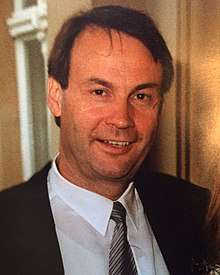Konrad Seppelt
Konrad Seppelt (born September 2, 1944)[1] is a German chemist and the former Vice President of the Free University of Berlin. He leads the research group AG Seppelt at the Institute of Inorganic and Analytical Chemistry, Free University of Berlin (Institut für Anorganische und Analytische Chemie der Freien Universität Berlin).

Positions held include:
- 1969-1979: Various positions at the University of Heidelberg
- 1974-1975: Visiting professor: University of California, Berkeley
- 1980-1982: Professor of Chemistry at the Institute of Inorganic and Analytical Chemistry, Free University of Berlin (Institut für Anorganische und Analytische Chemie der Freien Universität Berlin)
- 1982: Wilsmore Fellowship: University of Melbourne
- 1983-1991: Professor of Chemistry at the Institute of Inorganic and Analytical Chemistry, Free University of Berlin (Institut für Anorganische und Analytische Chemie der Freien Universität Berlin)
- 1992-1993: Dean of Natural Sciences at the Free University of Berlin
- 1994-1995: Vice President of the Free University of Berlin
- 1996-1997: Dean of Natural Sciences at the Free University of Berlin
- since 1997: Professor of Inorganic Chemistry and Head of the AG Seppelt at the Free University of Berlin
In the year 2000 Konrad Seppelt was the first scientist to form a compound between a noble gas and a noble metal, something that had previously been deemed impossible due to the inert nature of these chemical groups. In a series of experiments the compound Tetraxenonogold(II) was developed and subsequently published in Science.
From 1980 to 1982 he was the youngest Professor in West Germany.
Awards
- Chemiepreis: Akademie der Wissenschaften zu Göttingen (1976)
- Award for Creative Work in Fluorine Chemistry of the American Chemical Society(1996)
- Wilhelm-Klemm-Preis für Anorganische Chemie (2001)
Publications
Konrad Seppelt has published over 350 publications, including several papers in journals such as Science.
Popular publications
- Cutting Edge, Konrad Seppelt, The (London) Times Higher Education Supplement, November 10, 2000, p. 24.
- The Future of Chemistry ... , Editorial, Angew. Chem. Int. Ed. 2004, 43, 3618 –3620
- Science, Isolation and structural and electronic characterization of salts of the decamethylferrocene dication. August 2016 12;353(6300):678-82
- Science, Xenon as a complex ligand: the tetra xenono Gold(II) cation in AuXe(4)2+(Sb(2)F(11)-)(2). 2000 Oct 6;290(5489):117-8.
- Science, Response: Structure of W(CH3)6. 1996 Apr 12;272(5259):182b-3b.
Scientific publications
A random selection of Prof Seppelt's publications:
- K. Seppelt (1976). "Arsenic Pentachloride, AsCl5". Angew. Chem. Int. Ed. Engl. 15 (6): 377–378. doi:10.1002/anie.197603771.
- Seppelt, Konrad (June 1979). "Recent Developments in the Chemistry of Some Electronegative Elements". Accounts of Chemical Research. 12 (6): 211–216. doi:10.1021/ar50138a004.
- Seppelt, K. “Selenoyl difluoride” Inorganic Syntheses, 1980, volume XX, pp. 36–38. ISBN 0-471-07715-1.
- Ali Reza Mahjoub; Xiongzhi Zhang; Konrad Seppelt (1995). "Reactions of the Naked Fluoride Ion: Syntheses and Structures of SeF62− and BrF6−". Chemistry: A European Journal. 1 (4): 216. doi:10.1002/chem.19950010410.
- Seppelt, K., Pfennig, V. Science 1996, 271, 626-8.
- Kleinhenz, S., Pfennig, V., Seppelt, K. Chem. Eur. J. 1998, 4, 1687-91.
- Haupt S, Seppelt K (2002). "Solid State Structures of AsCl5 and SbCl5". Zeitschrift für Anorganische und Allgemeine Chemie. 628 (4): 729–734. doi:10.1002/1521-3749(200205)628:4<729::AID-ZAAC729>3.0.CO;2-E.
- Konrad Seppelt, Stefan Seidel; Seppelt, K (2000-10-06). "Xenon as a Complex Ligand: The Tetra Xenono Gold(II) Cation in AuXe42+(Sb2F11−)2". Science. 290 (5489): 117–118. Bibcode:2000Sci...290..117S. doi:10.1126/science.290.5489.117. PMID 11021792.
- Hwang, I; Seppelt, K. (2000). "The structures of ReF8− and UF82−". Journal of Fluorine Chemistry. 102 (1–2): 69–72. doi:10.1016/S0022-1139(99)00248-1.
- A. Ellern; T. Drews; K. Seppelt (2001). "The Structure of Carbon Suboxide, C3O2, in the Solid State". Zeitschrift für Anorganische und Allgemeine Chemie. 627 (1): 73–76. doi:10.1002/1521-3749(200101)627:1<73::AID-ZAAC73>3.0.CO;2-A.
- Seppelt, K. Accounts of Chemical Research 2003, 36(2), 147-153.
References
- "The Robert A. Welch Foundation Research Bulletin" (51). 1988: 26. Cite journal requires
|journal=(help)